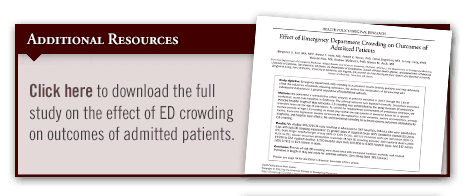Previous studies have sought to establish a definitive relationship between ED crowding and subsequent mortality, but these investigations often have shortcomings, such as small hospital samples and a lack of adjustment for comorbidities, primary illness diagnoses, and potential hospital-level confounders. In addition, many of these analyses restrict data to specific subgroups, such as patients with acute myocardial infarction, trauma, pneumonia, or critical illness.
New Evidence on Inpatient Death
In an effort to address these limitations, my colleagues and I conducted a study to assess the effect of ED crowding on patient outcomes. Our study, which was published in the Annals of Emergency Medicine, looked at nearly 1 million admissions through EDs across California. Daily ambulance diversion was the measure of ED crowding.
According to our results, ED crowding was associated with 5% greater odds of inpatient death. Patients who were admitted on days with high ED crowding had 0.8% longer hospital stays and 1.0% increased costs per admission. Periods of high ED crowding were associated with 300 excess inpatient deaths, 6,200 hospital days, and $17 million in costs. These findings persisted after extensively adjusting for patient demographics, comorbidities, and primary discharge diagnosis. Although other analyses have reported similar associations, our study generalizes these findings to a larger sample of hospitals and unselected admissions from the ED.
ED Crowding: A Marker of Poor Quality Care
Our findings support the notion that ED crowding is a marker of poor quality of care. Unfortunately, factors underlying the issue of ED crowding are likely to become worse. As Americans are living longer than ever, this has increased the volume, complexity, and acuity of patients. In the United States, the number of EDs increased by 4% from 2001 to 2006, but the number of ED visits increased by 11% during the same period. Attempts have been made to maximize inpatient bed occupancy, but this has reduced the ability of hospitals to absorb new patients and increased the prevalence of admitted patients who are being boarded in EDs. The availability or implementation of universal health insurance is unlikely to slow these trends.
“Factors underlying the issue of ED crowding are likely to become worse.”
CMS recently initiated hospital-level collection of several ED throughput measures, but these data will not be available to the public until 2014, and it’s unclear how these metrics will be used to improve performance. For the short term, efforts to reduce ED crowding will likely focus on hospital-level interventions. Future research should test and assess whether certain interventions can decrease adverse events and resource use.
In 2006, the Institute of Medicine (IOM) described an overburdened U.S. emergency care system and outlined potential policy remedies. Despite mounting evidence that ED crowding reduces access to emergency care, leads to worse quality of care, and decreases patient satisfaction, few systematic actions have been initiated to address the crisis of ED crowding. Policymakers should heed the recommendations of the IOM and address ED crowding as an important public health priority.




 admin
admin